Article
Basal Insulin Therapy in Type 2 Diabetes Management: What the Pharmacist Should Know
Author(s):
Guidance on the use of basal insulins (BI) and insulin pens to enable pharmacists to answer questions regarding the safe and effective use of BI for the management of diabetes.
Introduction
In 2018, an estimated 26.9 million Americans had a diagnosis of diabetes, with type 2 diabetes (T2D) accounting for 90%–95% of cases.1 Community pharmacists are in a unique position to provide education and advice regarding the management of diabetes using basal insulin (BI) therapy. The importance of this role is likely to increase as the number of people with diabetes continues to grow.2
The year 2021 marks the 100th anniversary of the discovery of insulin by Frederick Banting and John Macleod;3,4 since then, insulin therapy has evolved considerably (Figure 14-6). The first BI analog, insulin glargine 100 units(U)/mL7 (Gla-100), introduced in 2000, was a breakthrough in the field of insulin therapy and continues to be a gold standard treatment.8
Click image to enlarge.
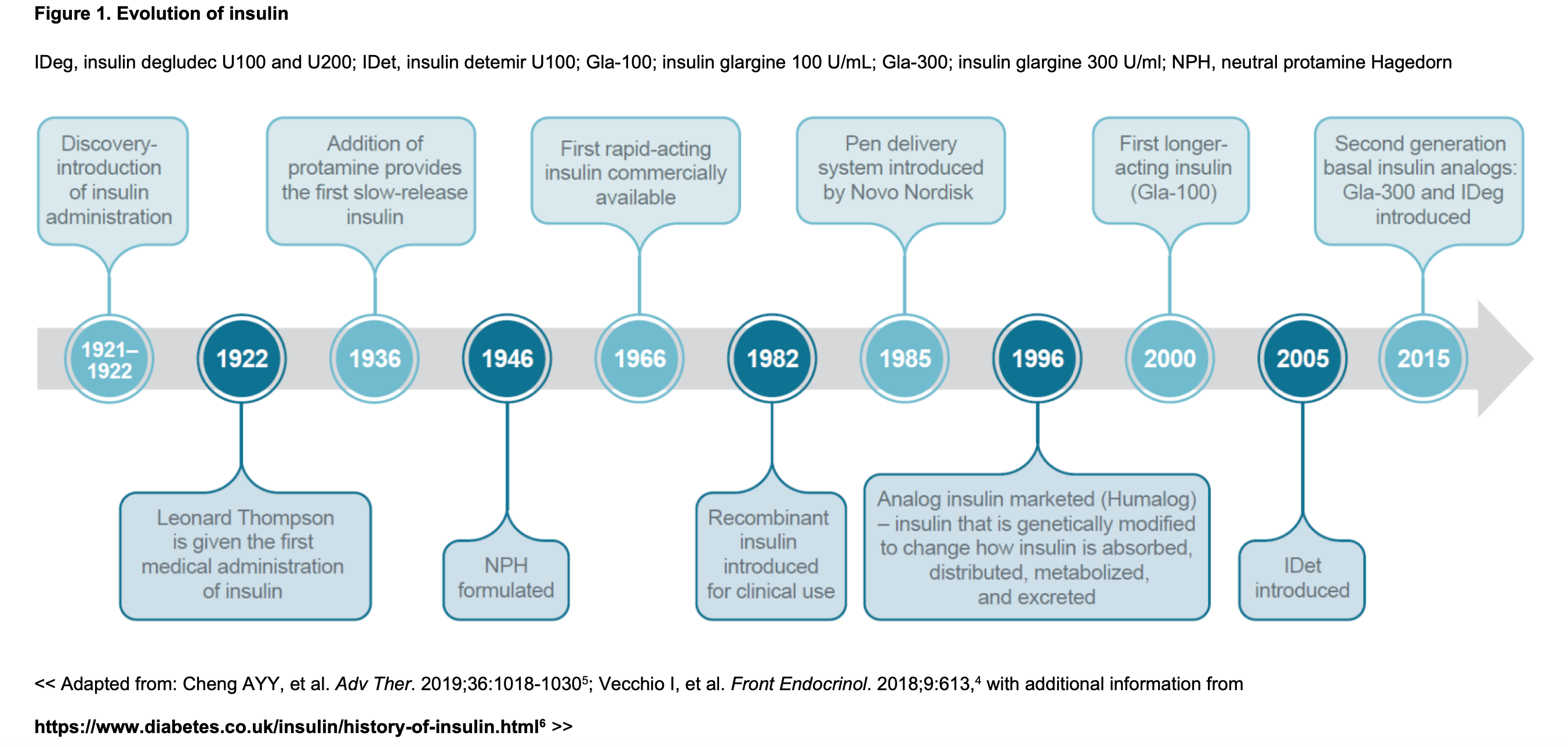
This was followed by insulin detemir U1009 (IDet) in 2005. It was another decade before the second-generation BIs, insulin glargine 300 U/mL10 (Gla-300) and insulin degludec (IDeg U100 and IDeg U200)11 were approved. Many people with long-standing T2D require insulin therapy. Table 1 summarizes recommendations for the use of BIs in people with T2D.12,13
Click image to enlarge.
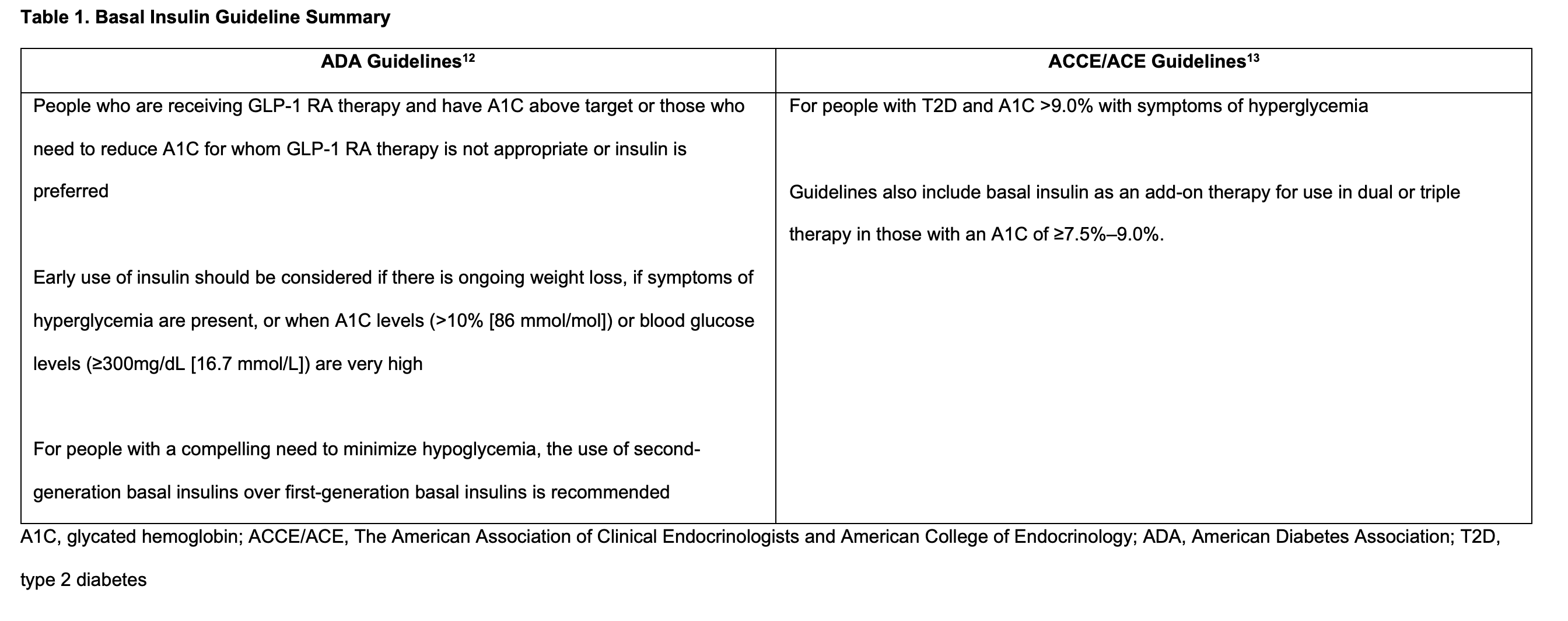
Here, we provide guidance on the use of BIs and insulin pens to enable pharmacists to answer questions regarding the safe and effective use of BI for the management of diabetes.
Why is insulin needed?
T2D is a progressive, multifactorial disease with several pathophysiologic abnormalities (in muscle, pancreas [alpha- and beta-cells], fat, and the liver, gut, kidneys, and brain), known as “the ominous octet” (Figure 2).14-16 In particular, the decline in function of pancreatic beta-cells is a constant, worsening feature resulting in an inability to produce insulin.
Click image to enlarge.
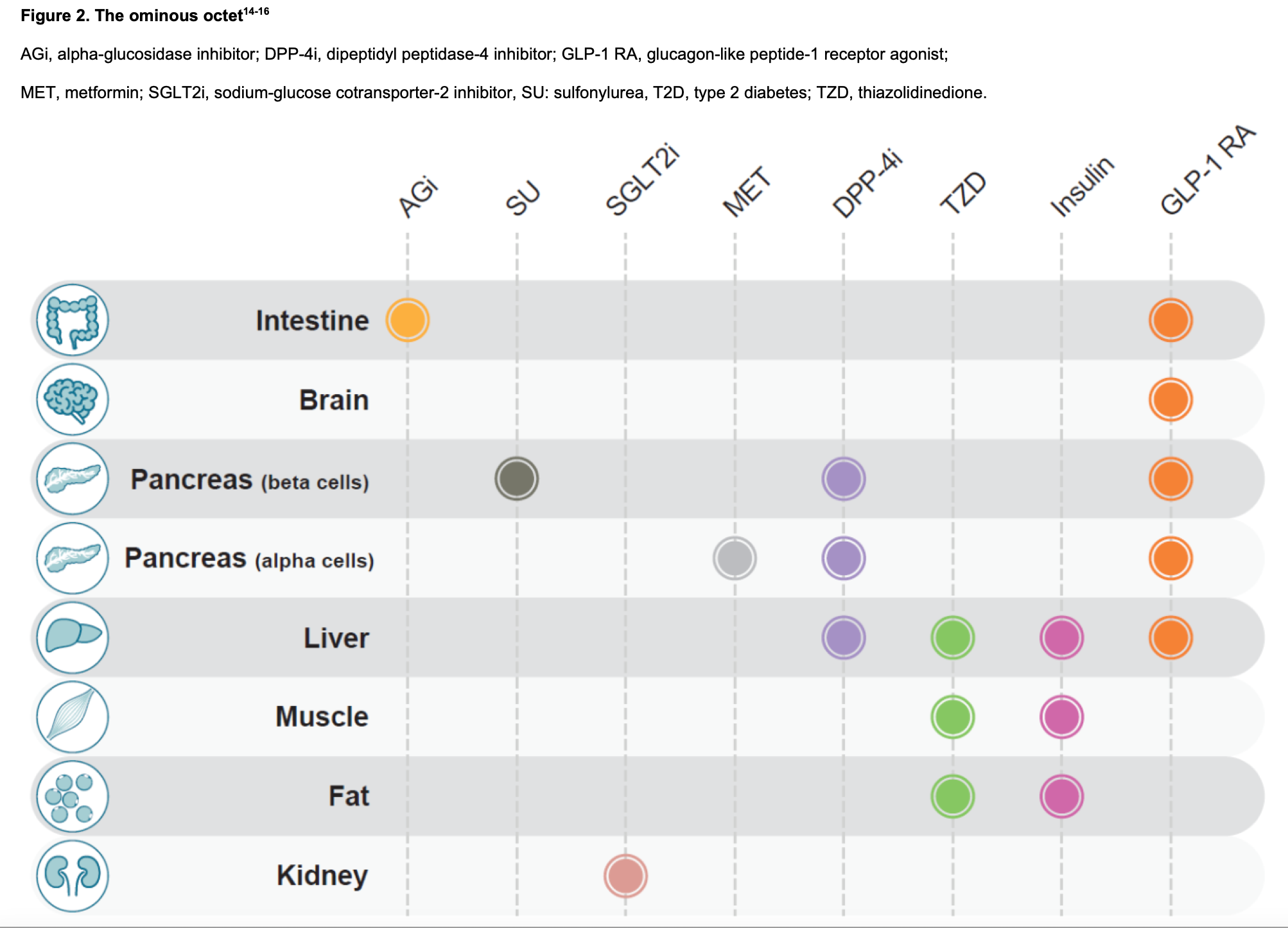
In fact, by diagnosis, approximately 40%–50% of beta-cell function is lost, with a further loss of 4%–5% each year thereafter.17 Therefore, exogenous insulin is needed to replace that which would normally be produced by beta-cells.
The aim of using BI is to provide glucose control throughout the day, achieved through a duration of action of up to 24 hours or, in the case of second-generation BIs, 36–42 hours (Table 27,9-11,18-22). Thus, BI is often the first type of insulin used in the management of T2D.12
Click image to enlarge.
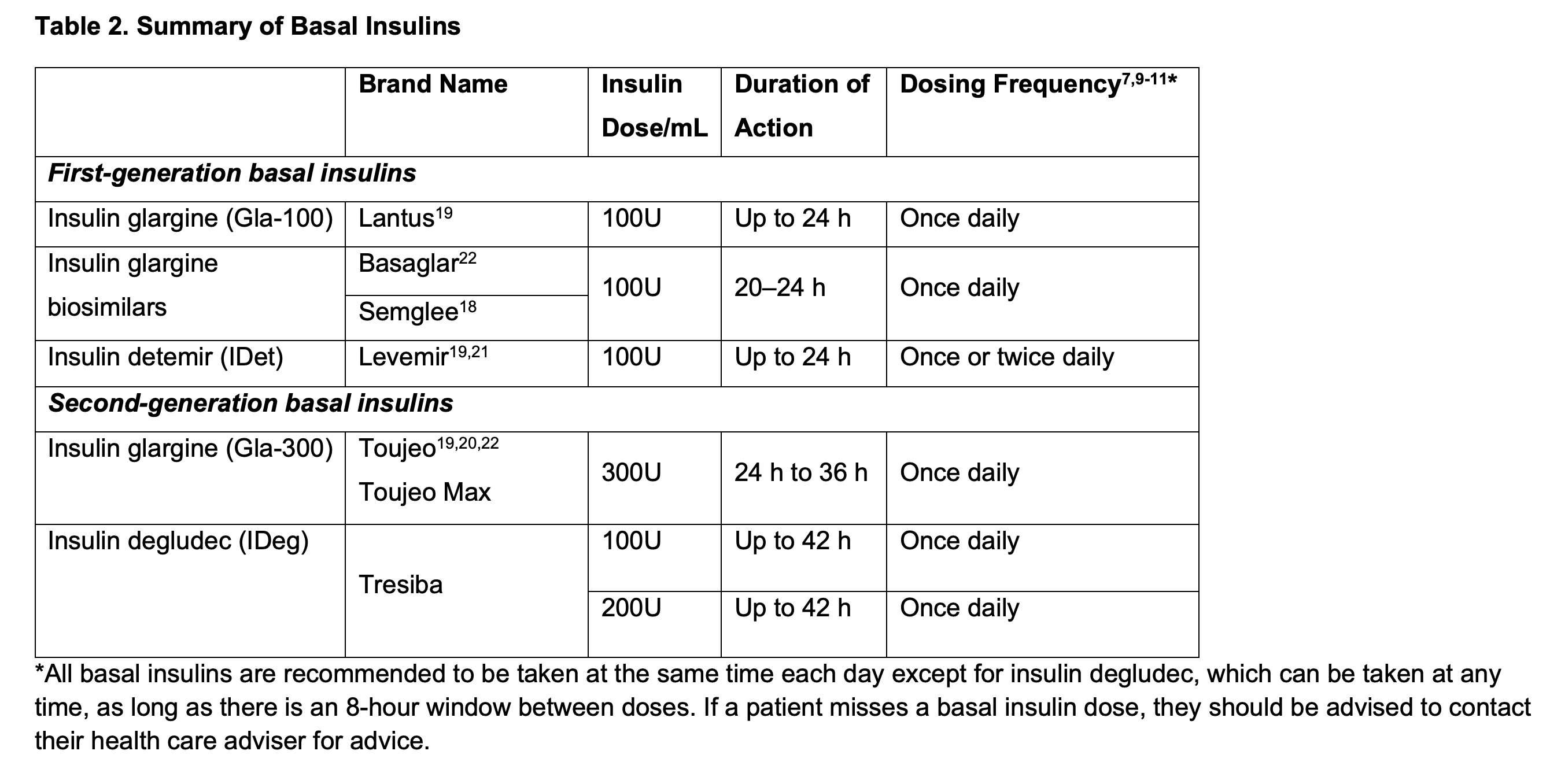
Key Differences in BI Formulations: (1) Stable vs Peaks in Insulin Activity; (2) Duration of Action (≤24 vs >24 h); (3) Variability in Insulin Exposure
Several different BIs are available (Table 2). The second-generation BIs Gla-300 and IDeg provide a longer duration of action than Gla-100 or IDet (Figure 3). Gla-300 and IDeg-U200 deliver the same number of units as the first-generation BIs and IDeg-U100, in a smaller volume—one-third of the volume for Gla-300 and half for IDeg-U200.19,23
Click image to enlarge.
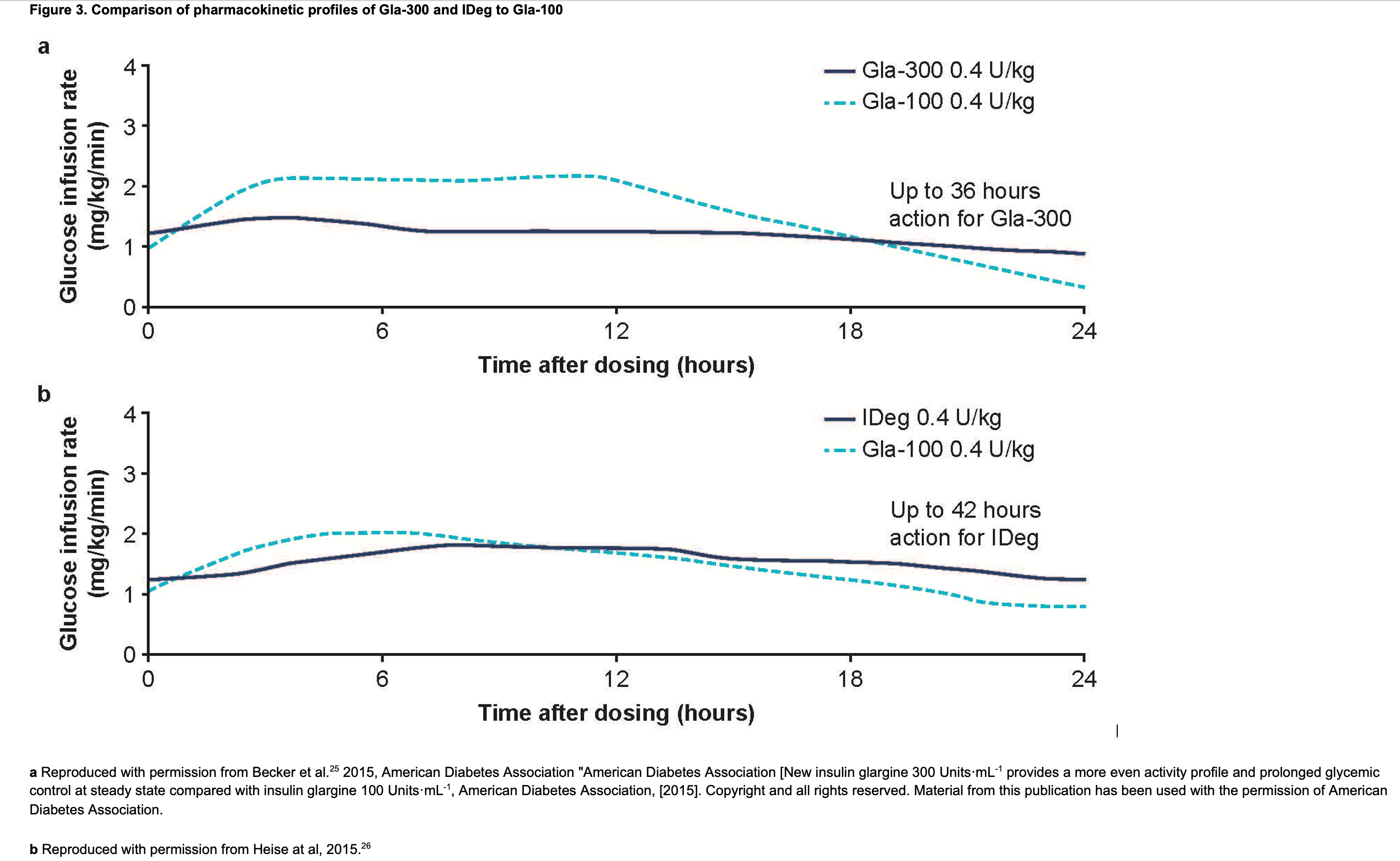
In studies comparing pharmacokinetic (PK)/pharmacodynamic (PD) profiles of Gla-300 or IDeg-U100/U200 with Gla-100, the second-generation BIs have shown a longer duration of action (>24 vs ≤24 h) and more stable glucose profiles with less variability throughout the day and between days.24-26 Second-generation BIs have longer half-lives than first-generation BIs (19 and 25 h for Gla-300 and IDeg, respectively), so it takes 4–5 days to reach 80%–90% steady state.19
Therefore, it is not recommended to make dose increases more often than every 3–4 days. To those receiving insulin, this may be perceived as a delay in efficacy; it is recommended to proactively inform people about this.
Understanding insulin concentration is critical. In general, when converting from one BI to another, a 1:1 conversion is used. For example, 10 units of Gla-100 or IDet or IDeg-U100 is the same as 10 units of Gla-300 or IDeg-U200. The second-generation BIs deliver the same number of units of insulin in a smaller volume. Some patients may require a slightly higher dose of Gla-300 when converting from glargine 100U.10 Dosing changes are summarized in Table 3.
Click image to enlarge.
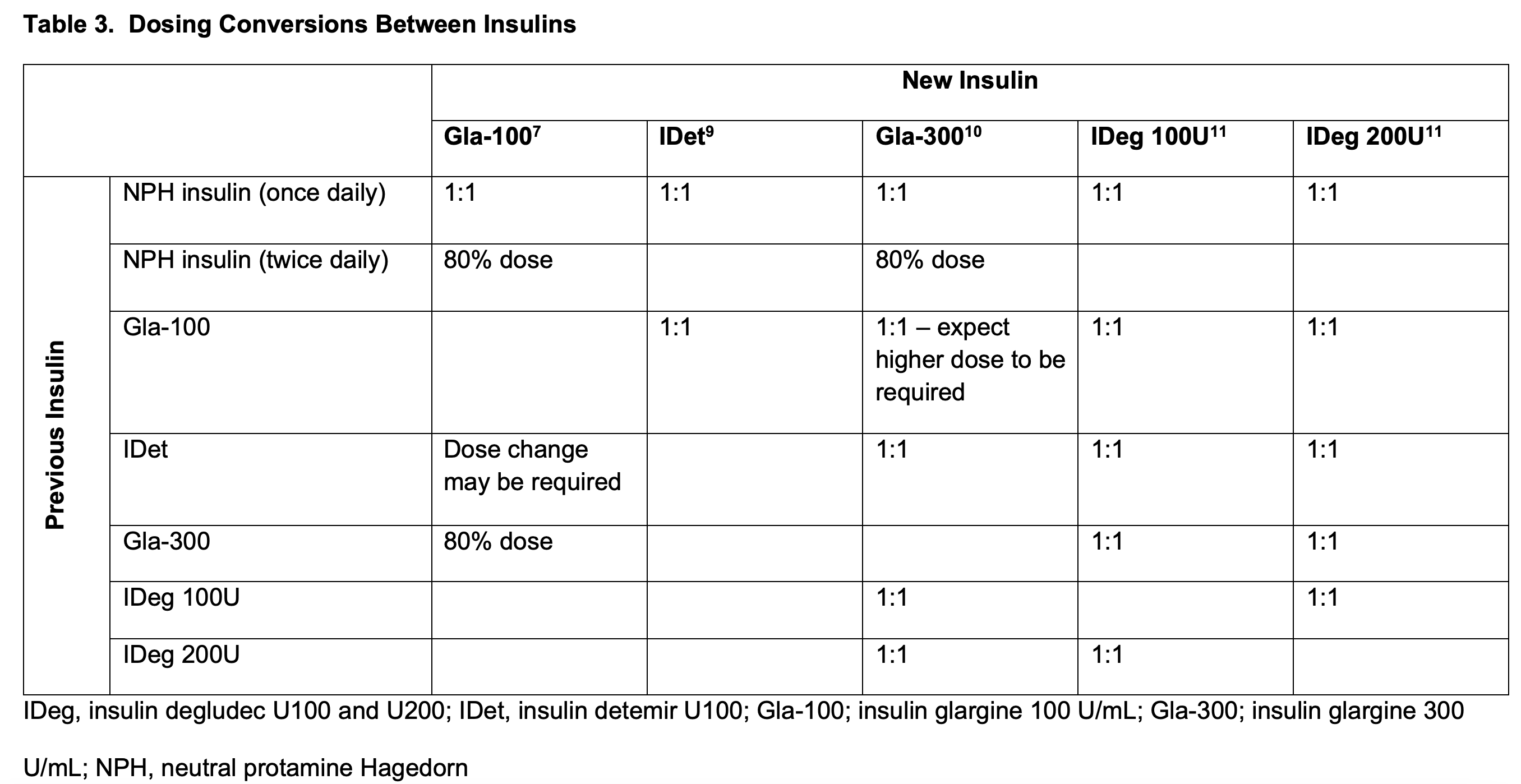
When should I request further information from the prescriber or query the prescription?
BIs are usually administered once daily. If a patient has a prescription for a first-generation BI prescribed twice a day, this could be because it may not be providing 24-hour coverage, or the prescribed dose is greater than 80U. Second-generation BIs (Gla-300 or IDeg), which are administered once daily due to their longer half-lives, and because of availability of higher capacity pens that allow up to 160U per injection, could simplify delivery of insulin for those in whom doses >80U are required.
To avoid over-basalization, it is important to contact the prescriber if it appears that the BI dose has been titrated beyond an appropriate level without achieving glycemic control, which can occur because treatment guidelines do not provide a definitive upper dose limit.27
The American Diabetes Association Standards of Care state that BI doses greater than ∼0.5 U/kg, high bedtime-morning or post-preprandial glucose differential (e.g. ≥50 mg/dL), hypoglycemia, and high variability, are all clinical signals that should prompt evaluation for over-basalization.12 This could be an indication that mealtime insulin coverage is required.
Other situations for pharmacist intervention are if the prescribed insulin is not covered by a patient’s health plan or is not listed as a preferred formulary item, or if the patient has a duplicate prescription. If the patient has received unclear or incorrect instructions regarding titration, this may be solved by providing the correct information, or by referring the patient to the prescriber or diabetes educator.
How is BI Administered?
BI can be taken in addition to oral antihyperglycemic medications and GLP-1 RA therapies. When starting BI, oral medications (except for sulfonylureas) and GLP-1 RAs are usually continued. Metformin is continued unless there is a contraindication (estimated glomerular filtration rate <30 mL/min/1.73 m2).12 Sulfonylureas may need to be discontinued to avoid hypoglycemia.
BI is usually injected via an insulin pen. Many people prefer insulin pens to the vial and syringe method28 because they are perceived to be safe and convenient to use with low risk for medication errors.29 The second-generation BIs have more units of insulin per pen, which means each pen will last longer.
Insulin pens are generally packaged in boxes of 1 to 5. In 2019, the FDA issued a recommendation that insulin pens should be dispensed in the original sealed box and not individually; however, the FDA recognizes that HCPs may use their professional judgement to dispense individual pens.30 An overview of the different insulin pens is provided in Table 4.7,9-11,18,31
Injection guidelines recommend use of a 4-mm pen needle to avoid intramuscular injection.32 Needles should be used only once. All BIs are recommended to be injected at the same time each day, except IDeg, which can be taken at any time as long as there is an 8-hour window between doses.11 If a patient misses a BI dose, they should be advised to contact their health care provider for advice.
Use and Storage of Insulin Pens
The pharmacist should be knowledgeable about the differences between insulin pens. Unopened insulin should be refrigerated (39.2 to 46.4oF). As injection of cold insulin can be painful, insulin pens should be removed from the refrigerator at least 30 minutes before use. Once removed, pens can be stored at room temperature; storage times at room temperature vary between pens (Table 4). When traveling, it is advisable to pack double the amount of insulin needed and prearrange to pick up extra supplies in case insulin is lost or is not useable.33
Click image to enlarge.
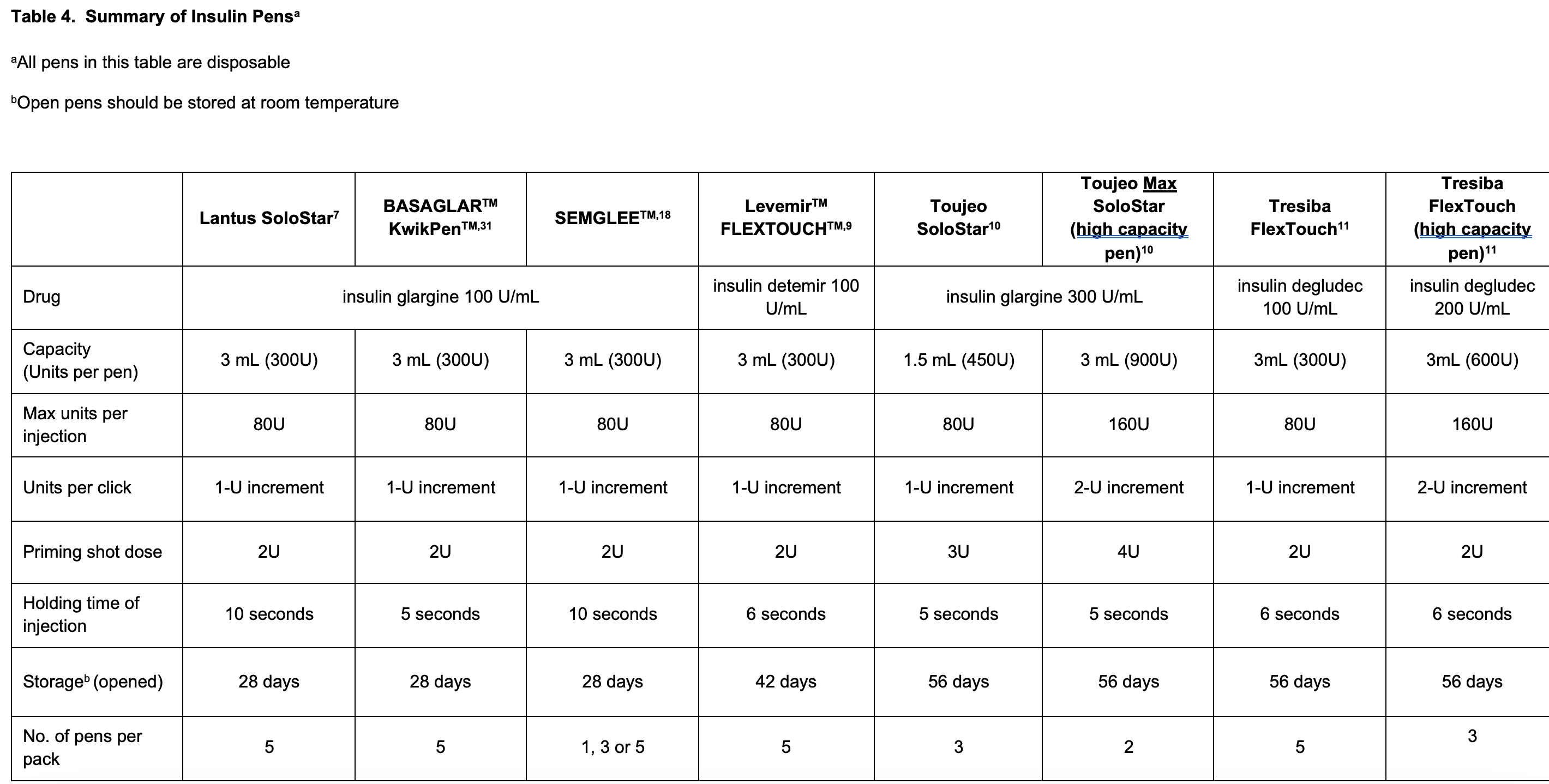
If traveling by air, insulin should be kept in hand luggage, such as a coolbag/box, polystyrene container, or wide-necked vacuum flask.33 In a hot climate it is advised to keep insulin in a refrigerator, otherwise in the coolest, darkest part of the room, and if it gets too hot, cover it with a cold, wet cloth.33
The insulin pen needle has several components (Figure 4). To install the needle, remove the paper tab from the outer shield, screw the needle onto the pen (do not over-tighten), pull the outer shield off and put it aside (it will be needed to remove the needle from the pen), then pull the inner shield off and discard.
Click image to enlarge.
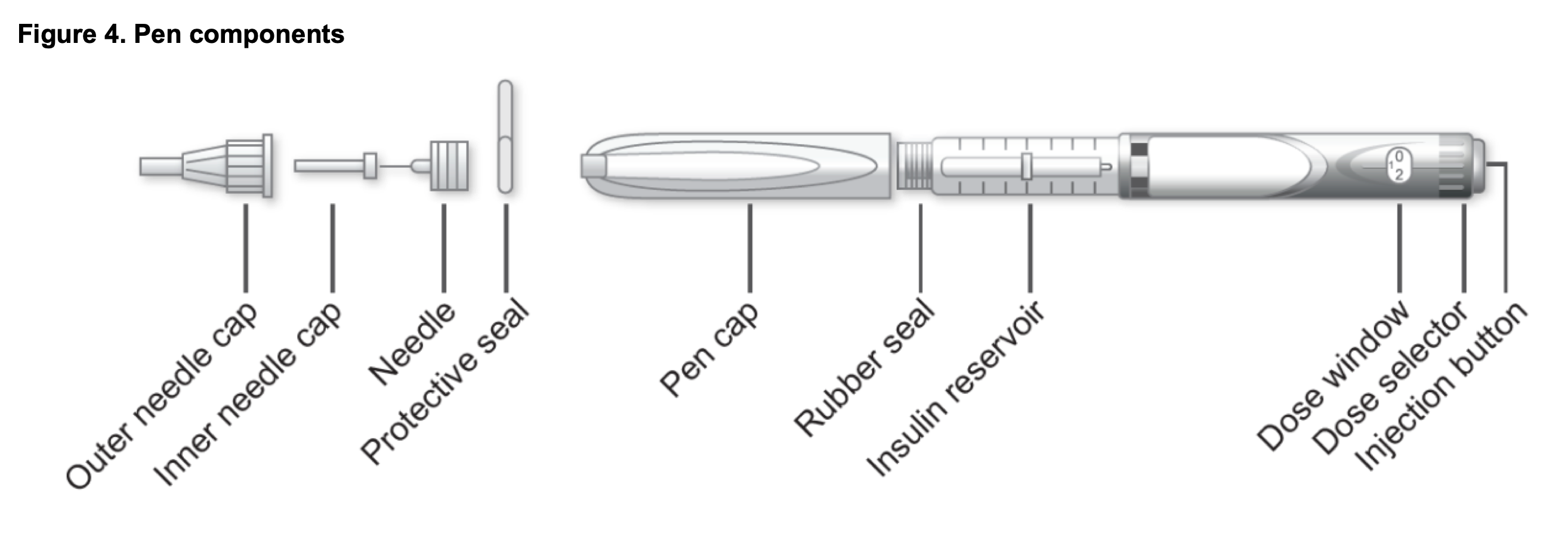
The pen needs to be primed prior to each use to ensure it is working properly and to remove any air bubbles. To do this, dial the number of units per the pen instructions and then press the button to shoot some insulin into the air. If insulin drops are not seen after repeated priming and ensuring proper placement of the pen needle, the pen should not be used.
Sometimes when the pen needle is attached to the pen, insulin drops may be seen, but priming still needs to be performed. Once primed, turn the dial to the correct dose. Patients should be aware of the number of units by which the dial increases the dose (1U or 2U, depending on the pen; Table 4). Double-check the dose before injecting. Clean the chosen injection site with alcohol and allow to dry.
Click image to enlarge.
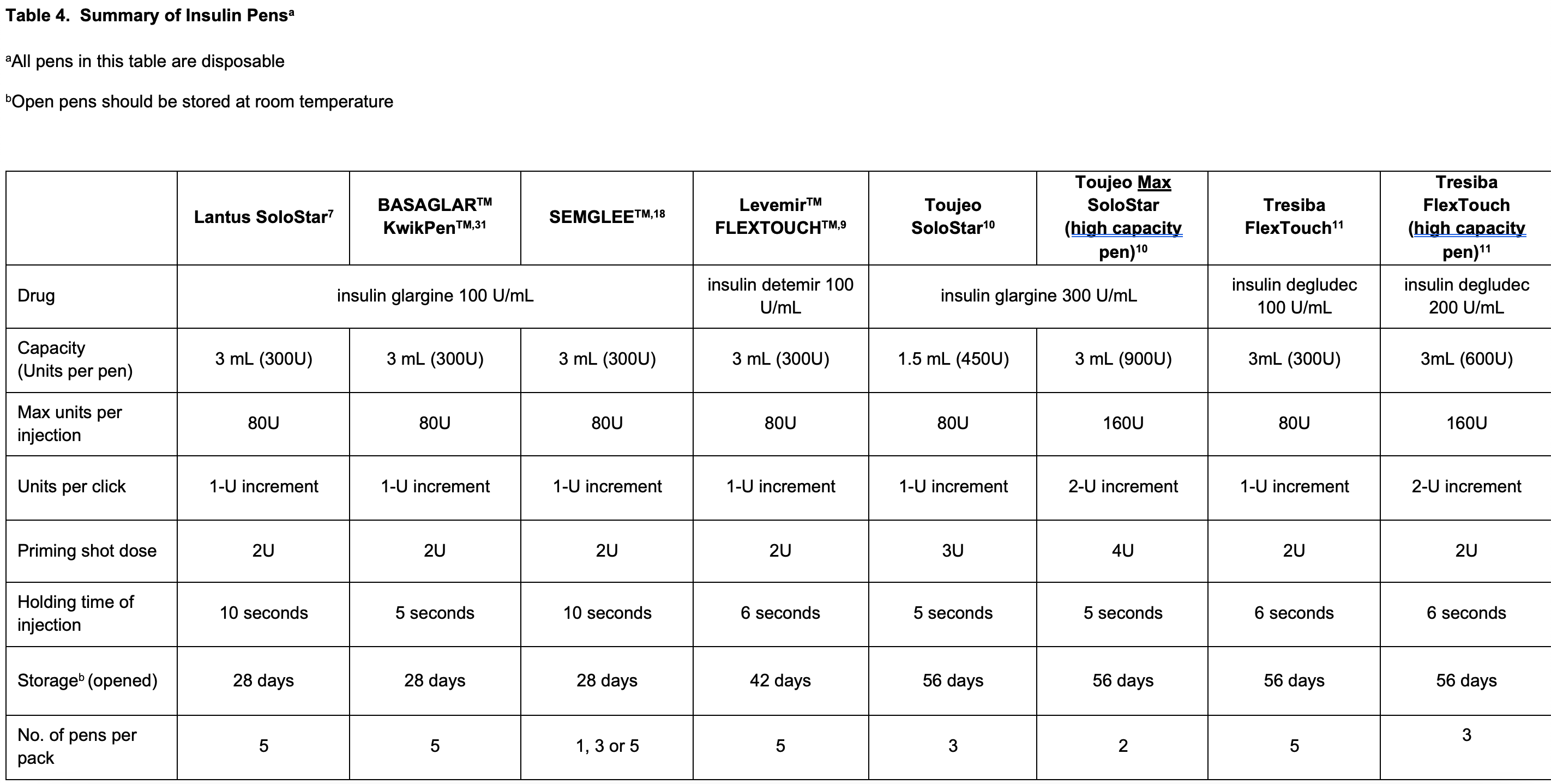
Do not inject into areas that have wounds or bruising and vary/rotate the injection site to avoid lumps or swelling. After injection, wait before removing the needle from the skin as indicated in the specific instructions for the pen in use (Table 4). Bleeding is rare; if blood is seen, press on the injection site for 5–10 seconds, do not rub the skin. Put the outer shield back on the needle and remove and safely dispose of the needle. Replace the cap on the pen.
BI Titration
The ADA Standards of Care state that starting doses of BI can be estimated based on body weight (0.1–0.2 U/kg/day) and degree of hyperglycemia.12 The most common titration schedules specify following a treat-to-target schedule or increasing dose by a set amount every 2–3 days,34 or every 3–4 days for the second-generation BIs, Gla-300 and IDeg (U100/U200).10,11
The decision on which schedule to use should be based on a discussion between the clinician and the patient, comfort of both parties, and follow-up plans.34 Other evidence-based algorithms may be used.35 Patient-led titration has been shown to be non-inferior to physician-led titration, suggesting that diabetes self-management education and support programs on BI should be widely adopted in clinical practice.35
What are the Adverse Effects of BI?
Hypoglycemia
Regardless of the type of insulin taken, people who receive insulin therapy need to be aware of the symptoms of hypoglycemia (sweating, tiredness, dizziness, hunger, tingling lips, feeling shaky, palpitations, turning pale, and being easily irritated, tearful, anxious, or moody).36
Hypoglycemia is a particular concern during intensification of insulin treatment, for example, when a prandial insulin is added to BI. Fasting self-monitored blood glucose, use of real-time continuous glucose monitoring systems, and appropriate titration of BI can reduce the risk of hypoglycemia, as can dietary and lifestyle changes.
Studies have demonstrated a reduced risk of overall documented or severe hypoglycemia, and severe nocturnal hypoglycemia in those receiving second-generation BIs versus first-generation BIs; the reduction in A1C is comparable.37-42
All patients injecting BI should be educated on management of hypoglycemia. Having glucagon available for use in an emergency would be prudent and is another area in which a pharmacist can make an intervention.
Weight gain
Modest weight gain is a common adverse effect of insulin therapy and is similar for second-generation and first-generation BIs.38-40
Individual weight loss needs can be addressed on personal and cultural preference. For those who are overweight or obese, diet, physical activity, and behavioral therapy designed to achieve and maintain ≥5% weight loss are recommended.12
Other adverse effects
It is important to be aware of other adverse reactions that can occur after injection of BIs.7, 9-11 With all insulin products, allergic reactions, including severe life threatening allergic reactions (anaphylaxis), can occur, however these are rare.43 Injection site reactions, including pruritus, rash and edema can also occur,7, 9-11 these are often self-limiting. Some patients may experience lipodystrophy (abnormal fat distribution) with long term use of insulin.7, 9-11
Conclusions
The advent of the BIs in the early 2000s provided an important treatment option to help people with T2D achieve glycemic control. Second-generation BIs have more stable and longer PK/PD profiles with similar efficacy to first-generation BIs, but with lower risk of hypoglycemia. In addition, second-generation BIs have a variety of pen options with larger capacities and the ability to offer once-daily dosing, even for patients who require high doses.
By being able to explain why BI is needed and how to administer and titrate BI, and educate on the potential adverse effects, the pharmacist can play a vital role in empowering people with T2D to control their blood glucose more effectively.
Infographic
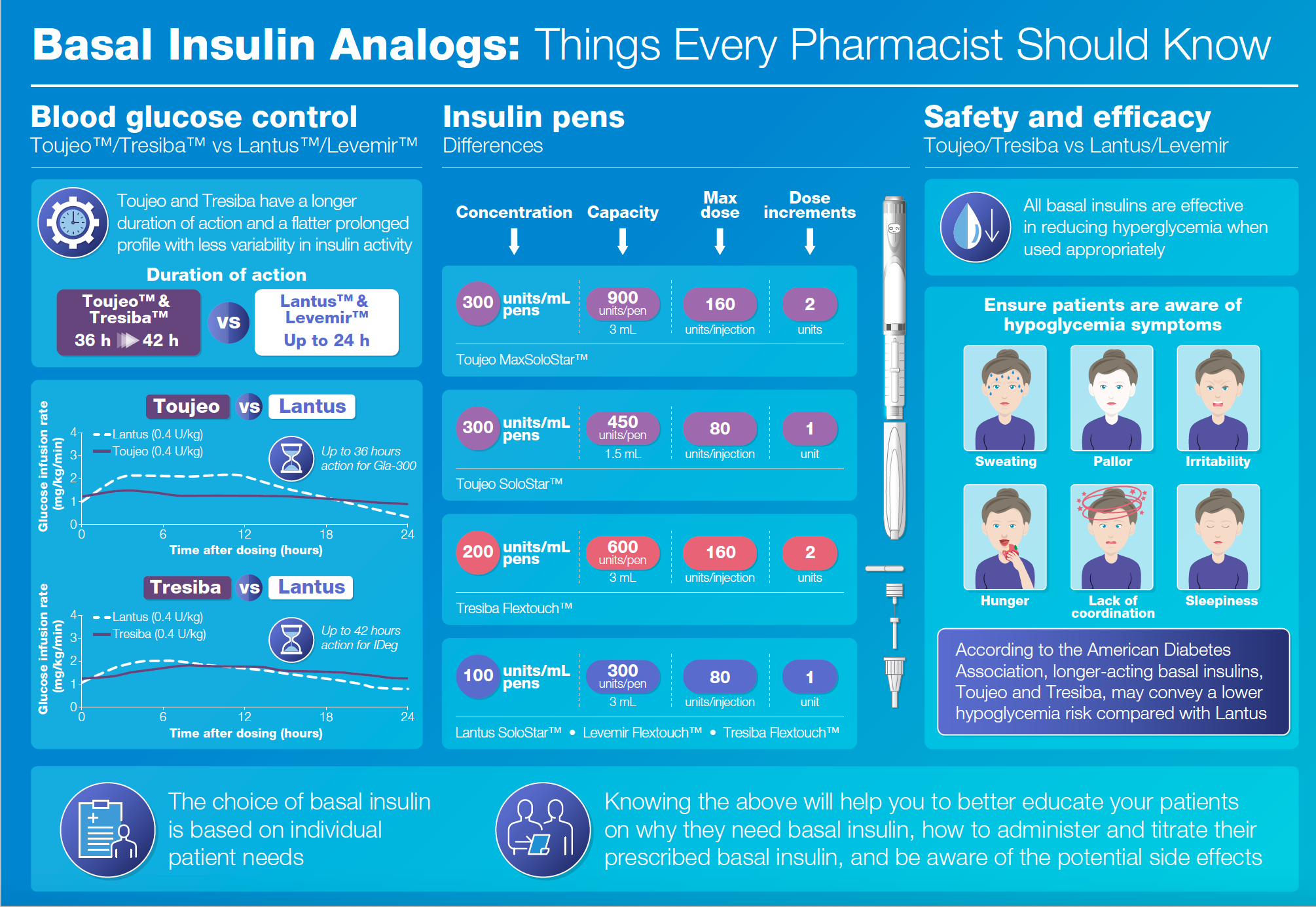
Authorship
Jennifer Goldman, PharmD, CDES, BC-ADM, FCCP, Department of Pharmacy Practice, School of Pharmacy, MCPHS University, Boston, MA, USA and Clinical Pharmacist, Well Life Medical, Peabody, MA.
Dhiren Patel, PharmD, CDE, BC-ADM, BCACP, Department of Pharmacy Practice, School of Pharmacy, MCPHS University, Boston, MA, USA and Department of Endocrinology, VA Boston Healthcare System, Boston, MA, USA.
Viral N. Shah, MD, Barbara Davis Center for Diabetes, University of Colorado Anschutz Medical Campus, Aurora, CO, USA.
Acknowledgments
The authors received medical writing support in the preparation of this manuscript provided by Barrie Anthony, PhD, CMPP, and Helen Jones, PhD, CMPP, of Evidence Scientific Solutions, funded by Sanofi US.
Disclosures
VNS reports receiving research support through University of Colorado from Sanofi US, NovoNordisk, Eli Lilly, Insulet, Dexcom, vTv Therapeutics, Mylan GmbH, NIH, and JDRF. VNS served on the advisory boards of Sanofi US and Medscape LLC.
JDG reports being a member of speakers’ bureaus for Abbott, Amarin, Eli Lilly, NovoNordisk, Sanofi, and Xeris.
DP is an advisor/consultant for Bayer, Eli Lilly, Insulet, Novo Nordisk, and Sanofi, and is on speakers’ bureaus for Abbott, Amarin, AstraZeneca, Boehringer Ingelheim, Dexcom, Eli Lilly, Merck, Novo Nordisk, Xeris, and Zealand.
References
1. Centers for Disease Control and Prevention. National Diabetes Statistics Report 2020; Estimates of Diabetes ands its Burden in the United States. 2020. https://www.cdc.gov/diabetes/data/statistics-report/index.html. Accessed January 2021.
2. Hughes JD, Wibowo Y, Sunderland B, Hoti K. The role of the pharmacist in the management of type 2 diabetes: current insights and future directions. Integr Pharm Res Pract. 2017;6:15-27.
3. Latres E, Finan DA, Greenstein JL, Kowalski A, Kieffer TJ. Navigating two roads to glucose normalization in diabetes: automated insulin delivery devices and cell therapy. Cell Metab. 2019;29(3):545-563.
4. Vecchio I, Tornali C, Bragazzi NL, Martini M. The discovery of insulin: an important milestone in the history of medicine. Front Endocrinol (Lausanne). 2018;9:613.
5. Cheng AYY, Patel DK, Reid TS, Wyne K. Differentiating basal insulin preparations: understanding how they work explains why they are different. Adv Ther. 2019;36(5):1018-1030.
6. Diabetes.co.uk. History of Insulin. 2019. https://www.diabetes.co.uk/insulin/history-of-insulin.html. Accessed Jan 2021.
7. Lantus. Lantus US prescribing insert. 2009. Accessed April 2021.
8. Hirose T, Chen CC, Ahn KJ, Kiljanski J. Use of insulin glargine 100 U/mL for the treatment of type 2 diabetes mellitus in East Asians: a review. Diabetes Ther. 2019;10(3):805-833.
9. Levermir (insulin detimir injection). Prescribing infromation. 2020; Novo Nordisk. https://www.novo-pi.com/levemir.pdf. Accessed January 2021.
10. Toujeo (insulin glargine injection). US Prescribing Information. 2015; sanofi-aventis U.S. https://www.accessdata.fda.gov/drugsatfda_docs/label/2015/206538lbl.pdf. Accessed January 2021.
11. Tresiba (insulin degludec injection). Prescribing information. 2015; Novo Nordisk. https://www.accessdata.fda.gov/drugsatfda_docs/label/2015/203314lbl.pdf. Accessed April 2021.
12. American Diabetes Association. Standards of medical care in diabetes — 2021. Diabetes Care. 2021;44(1):S1-S232.
13. Garber AJ, Handelsman Y, Grunberger G, et al. Consensus statement by the American Association of Clinical Endocrinologists and American College of Endocrinology on the comprehensive type 2 diabetes management algorithm – 2020 executive summary. Endocr Pract. 2020;26(1):107-139.
14. Cornell S. Continual evolution of type 2 diabetes: an update on pathophysiology and emerging treatment options. Ther Clin Risk Manag. 2015;11:621-632.
15. DeFronzo RA, Eldor R, Abdul-Ghani M. Pathophysiologic approach to therapy in patients with newly diagnosed type 2 diabetes. Diabetes Care. 2013;36 Suppl 2:S127-138.
16. Inzucchi SE, Bergenstal RM, Buse JB, et al. Management of hyperglycemia in type 2 diabetes, 2015: a patient-centered approach: update to a position statement of the American Diabetes Association and the European Association for the Study of Diabetes. Diabetes Care. 2015;38(1):140-149.
17. Wysham C, Shubrook J. Beta-cell failure in type 2 diabetes: mechanisms, markers, and clinical implications. Postgrad Med. 2020;132(8):676-686.
18. SEMGLEE (insulin glargine injection, solution). Prescribing information. Mylan Specialty. https://dailymed.nlm.nih.gov/dailymed/fda/fdaDrugXsl.cfm?type=display&setid=970259e5-179a-4116-9d09-f3f8ad052283. Accessed January 2021.
19. Goldman J, Kapitza C, Pettus J, Heise T. Understanding how pharmacokinetic and pharmacodynamic differences of basal analog insulins influence clinical practice. Curr Med Res Opin. 2017;33(10):1821-1831.
20. Janež A, Guja C, Mitrakou A, et al. Insulin therapy in adults with type 1 diabetes mellitus: a narrative review. Diabetes Ther. 2020;11(2):387-409.
21. Silver B, Ramaiya K, Andrew SB, et al. EADSG guidelines: insulin therapy in diabetes. Diabetes Ther. 2018;9(2):449-492.
22. UR Medicine Primary Care and Accountable Health Partners. Drug updates. In: UR Medicine Primary Care and Accountable Health Partners, ed2016.
23. Gough SC, Bhargava A, Jain R, Mersebach H, Rasmussen S, Bergenstal RM. Low-volume insulin degludec 200 units/mL once daily improves glycemic control similarly to insulin glargine with a low risk of hypoglycemia in insulin-naïve patients with type 2 diabetes: a 26-week, randomized, controlled, multinational, treat-to-target trial: the BEGIN LOW VOLUME trial. Diabetes Care. 2013;36(9):2536-2542.
24. Bailey TS, Pettus J, Roussel R, et al. Morning administration of 0.4U/kg/day insulin glargine 300U/mL provides less fluctuating 24-hour pharmacodynamics and more even pharmacokinetic profiles compared with insulin degludec 100U/mL in type 1 diabetes. Diabetes Metab. 2018;44(1):15-21.
25. Becker RH, Dahmen R, Bergmann K, Lehmann A, Jax T, Heise T. New insulin glargine 300 Units·mL-1 provides a more even activity profile and prolonged glycemic control at steady state compared with insulin glargine 100 Units·mL-1. Diabetes Care. 2015;38(4):637-643.
26. Heise T, Hovelmann U, Nosek L, Hermanski L, Bottcher SG, Haahr H. Comparison of the pharmacokinetic and pharmacodynamic profiles of insulin degludec and insulin glargine. Expert Opin Drug Metab Toxicol. 2015;11(8):1193-1201.
27. Meece J. Basal insulin intensification in patients with type 2 diabetes: a review. Diabetes Ther. 2018;9(3):877-890.
28. Korytkowski M, Bell D, Jacobsen C, Suwannasari R, FlexPen Study Team. A multicenter, randomized, open-label, comparative, two-period crossover trial of preference, efficacy, and safety profiles of a prefilled, disposable pen and conventional vial/syringe for insulin injection in patients with type 1 or 2 diabetes mellitus. Clin Ther. 2003;25(11):2836-2848.
29. Molife C, Lee LJ, Shi L, Sawhney M, Lenox SM. Assessment of patient-reported outcomes of insulin pen devices versus conventional vial and syringe. Diabetes Technol Ther. 2009;11(8):529-538.
30. U.S. Food and Drug Administration. FDA advises health care professionals and patients about insulin pen packaging and dispensing. 2020; FDA. https://www.fda.gov/drugs/drug-safety-and-availability/fda-advises-health-care-professionals-and-patients-about-insulin-pen-packaging-and-dispensing. Accessed May 2021.
31. Basaglar. BASAGLAR® (insulin glargine injection) 100 units/mL has no dosing differences with Lantus® (insulin glargine injection) 100 units/mL for insulin initiation. 2021. https://www.basaglar.com/hcp/dosing/kwikpen. Accessed January 2021.
32. Bahendeka S, Kaushik R, Swai AB, et al. EADSG guidelines: insulin storage and optimisation of injection technique in diabetes management. Diabetes Ther. 2019;10(2):341-366.
33. NHS Scotland. Travelling with insulin and other diabetes equipment.Information on storing and transporting your insulin. 2021. https://www.mydiabetesmyway.scot.nhs.uk/Content.aspx?id=70#gsc.tab=0. Accessed April 2021.
34. Patel D, Triplitt C, Trujillo J. Appropriate titration of basal insulin in type 2 diabetes and the potential role of the pharmacist. Adv Ther. 2019;36(5):1031-1051.
35. Castellana M, Procino F, Sardone R, Trimboli P, Giannelli G. Efficacy and safety of patient-led versus physician-led titration of basal insulin in patients with uncontrolled type 2 diabetes: a meta-analysis of randomized controlled trials. BMJ Open Diabetes Res Care. 2020;8(1):e001477.
36. NHS. Low blood sugar (hypoglycaemia). 2021. https://www.nhs.uk/conditions/low-blood-sugar-hypoglycaemia/. Accessed April 2021.
37. Bolli GB, Riddle MC, Bergenstal RM, et al. New insulin glargine 300 U/ml compared with glargine 100 U/ml in insulin-naïve people with type 2 diabetes on oral glucose-lowering drugs: a randomized controlled trial (EDITION 3). Diabetes Obes Metab. 2015;17(4):386-394.
38. Marso SP, McGuire DK, Zinman B, et al. Efficacy and safety of degludec versus glargine in type 2 diabetes. N Engl J Med. 2017;377(8):723-732.
39. Meneghini L, Blonde L, Gill J, et al. Insulin glargine 300 U/mL versus first-generation basal insulin analogues in insulin-naïve adults with type 2 diabetes: 12-month outcomes of ACHIEVE Control, a prospective, randomized, pragmatic real-life clinical trial. Diabetes Obes Metab. 2020;22(11):1995-2003.
40. Meneghini LF, Sullivan SD, Oster G, et al. A pragmatic randomized clinical trial of insulin glargine 300 U/mL vs first-generation basal insulin analogues in insulin-naïve adults with type 2 diabetes: 6-month outcomes of the ACHIEVE Control study. Diabetes Obes Metab. 2020;22(11):2004-2012.
41. Wysham C, Bhargava A, Chaykin L, et al. Effect of insulin degludec vs insulin glargine U100 on hypoglycemia in patients with type 2 diabetes: the SWITCH 2 randomized clinical trial. JAMA. 2017;318(1):45-56.
42. Yki-Järvinen H, Bergenstal R, Ziemen M, et al. New insulin glargine 300 units/mL versus glargine 100 units/mL in people with type 2 diabetes using oral agents and basal insulin: glucose control and hypoglycemia in a 6-month randomized controlled trial (EDITION 2). Diabetes Care. 2014;37(12):3235-3243.
43. Badik J, Chen J, Letvak K, SoTY. Hypersensitivity reaction to insulin glargine and insulin detemir in a pediatric patient: a case report. J Pediatr Pharmacol Ther. 2016;21(1):85-91.
Newsletter
Stay informed on drug updates, treatment guidelines, and pharmacy practice trends—subscribe to Pharmacy Times for weekly clinical insights.





